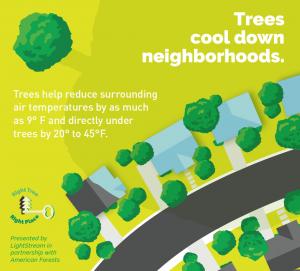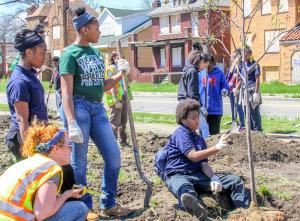NATIONWIDE EVALUATION OF TREE COVER SHOWS HUGE OPPORTUNITY TO REDUCE HEAT EXPOSURE AND BOOST AIR QUALITY AND EMPLOYMENT

Jad Daley, President and CEO American Forests.
Among large cities with most to gain: Chicago, Houston, Los Angeles, Detroit, Philadelphia, New York, Portland; Tree Solution Emerges for Rising Heat
WASHINGTON , DISTRICT OF COLUMBIA, UNITED STATES, June 22, 2021 /EINPresswire.com/ -- American Forests, the nation’s oldest national conservation organization, today released its first nationwide tally of Tree Equity scores, a calculation that evaluates equitable distribution of tree cover in the United States. The Tree Equity Score (TES) tool identifies the cities that can gain the most significant health, economic and climate benefits by increasing tree canopy in places of high need.
The 20 large cities (populations of 500,000+) with the most benefits to gain include: Chicago, Ill.; Columbus, Ohio; Detroit, Mich.; Fresno, Calif.; Houston, Fort Worth and El Paso, Texas; Hempstead and New York, N.Y.; Jacksonville, Fla.; Los Angeles, Calif.; Memphis, Tenn.; Milwaukee, Wis.; Oklahoma City, Okla.; Philadelphia, Penn.; Phoenix, Ariz.; Portland, Ore. and Sacramento, San Diego and San Jose, Calif.
TES combines socioeconomic status, existing tree cover, population density and other information for 150,000 neighborhoods and 486 metropolitan areas to determine whether locations have enough trees to provide optimal health, economic and climate benefits. Achieving Tree Equity nationwide requires planting 522 million trees, coast to coast, in metropolitan areas (places with 50,000+ people). Doing so would sustain 3.8 million jobs and annually absorb 9.3 million tons of carbon – the equivalent of taking 92 million cars off the roads. As the trees mature, they would mitigate 56,613 tons of particle pollution annually.
“Our Tree Equity Score will help make us all accountable and create action at the local, state and national levels,” said Jad Daley, president and chief executive officer of American Forests. “It shows us exactly where the problems exist, where we need to concentrate investment to solve them, and where we need to bring people together – all different types of people and organizations.”
Daley asserted that the Tree Equity scores should play a significant role in helping shape government, private-sector, and non-profit policies and funding for protecting existing trees, as well as planting and taking care of new ones.
TES documents trees are sparsest in under-resourced neighborhoods and more prominent in wealthier, often whiter communities. The findings confirm a disturbing pattern of inequitable distribution of trees that has deprived many communities of color of the health and other benefits that sufficient tree cover can deliver. Neighborhoods with a majority of people of color have 33% less tree canopy on average than majority white communities. And neighborhoods with 90% or more of their residents living in poverty have 41% less tree canopy than communities with only 10% or less of the population in poverty.
Benefits of increasing Tree Equity scores include:
Cooler temperatures, fewer deaths and illnesses. By providing shade, trees help prevent heat-related illnesses and deaths. Trees lower air temperature by up to seven degrees during the day and 22 degrees at night while absorbing pollutants, making it easier to breathe. Trees also help improve mental and physical health when outside exercising or relaxing under and around them. American Forests research in Dallas showed heat-related deaths could drop by 22% with a combination of trees and reflective surfaces.
Boosting the economy. Planting and taking care of trees can create jobs all along the urban forestry supply pipeline, from digging holes to taking care of trees to creating wood furniture, plus numerous adjacent jobs held by people who support these workers (i.e., tool manufacturers, restaurants, shippers, etc).Trees also lower utility costs by shading buildings in the summer and blocking wind in the winter.
Mitigating climate change. Trees in urban areas of the U.S. are responsible for 20 percent of all of the carbon emissions that forests in the U.S. capture and store. That amounts to nearly two percent of overall U.S. carbon emissions. Also, more trees mean less use of air conditioners and heaters, resulting in millions of tons of carbon that are not emitted. Trees help us adapt to climate change by absorbing water (which reduces flood risks), reducing air temperatures, and more.
TES calls America to action on Tree Equity. “It is a moral imperative that we do so,” Daley asserted. “This country is denying life and death infrastructure to people based on income and race. That's morally insupportable. This is just completely at odds with our values as a country.”
ABOUT AMERICAN FORESTS
American Forests is the first national non-profit conservation organization created in the US. Since its founding in 1875, the organization has been the pathfinders for the forest conservation movement. Its mission is to create healthy and resilient forests, from cities to wilderness, that deliver essential benefits for climate, people, water and wildlife. The organization advances its mission through forestry innovation, place-based partnerships to plant and restore forests, and movement building. TES is supported by the Doris Duke Charitable Foundation, EarthDefine, The Summit Foundation, Microsoft, Seed Fund and the United States Forest Service.
Contact:
Joanne Krell, 269.753.9392, joanne.krell@defycommunications.com
Joanne Krell
Defy Communications
joanne.krell@defycommunications.com
+1 269-753-9392
Legal Disclaimer:
EIN Presswire provides this news content "as is" without warranty of any kind. We do not accept any responsibility or liability for the accuracy, content, images, videos, licenses, completeness, legality, or reliability of the information contained in this article. If you have any complaints or copyright issues related to this article, kindly contact the author above.


